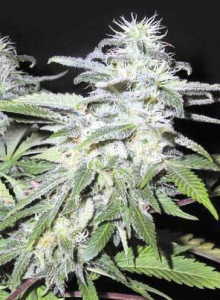
Afghanica is an F1 hybrid that is true to its roots. This predominantly indica plant grows short and stocky, with broad leaves and a thick canopy. Afghanica produces well when gardened inside or outdoors in most temperate regions, but yields are heaviest when it is grown in a sea of green (12-16 plants psm or 3-4 plants psf). Trim away lower branches before the onset of flowering; this allows the plant to devote all available energy to the light-immersed tops. Removing lower branches outdoors late in the season also increases airflow, limiting potential mold or pest problems.
In a normal season, Afghanica matures into a 6-foot (2-meter) tall Christmas tree, and may exhibit red or purple coloration in colder climates. No matter where she is grown, organic soil will foster a sweeter, more refined end product. Afghanica has low-to-medium nutrient requirements. Too many nutrients in the latter stages of maturation impair the taste. No nutrients should be given for the last 10 days before harvest. Although this strain often looks ready well beofre its 8-9 weeks of flowering are finished, the yield and potency increase tremendously in the last week. It is worth the wait.
When nearing harvest, Afghanica plants emit a petrol-type aroma at the slightest disturbance. The buds are fairly dense and very oily throughout. The coated smaller leaves are worth collecting, as they produce an abundance of heavy, oily resin when put through a screen. Smell and taste are typical Afghani – acrid, pungent and volatile, although the Skunk father lends a little sweetness. The high is potent, lethargic and physical in nature. It comes on slowly and has a long lasting depth and density. If smoked late at night, the effects can often still be felt in the morning. Medicinally, Afghanica is effective relief for insomnia and chronic pain.
Ever smoke or grow Afghanica? Tell us about it in a comment below!
